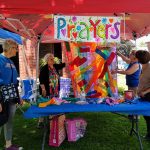Featured image: Held on Epiphany eve, the annual Christmas Tree Burn at St. Christopher’s Episcopal Church in Gladwyne, Pennsylvania is a popular community event. Photo by the Rev. Callie Swanlund.
Last week on Epiphany, my family took down our Christmas tree and lights. This is never a happy day for me. The Christmas glow is gone, leaving a dark and empty space in our living room. That darkness feels at odds with the illumination and excitement of the Epiphany. So I was intrigued when I heard this year about an old but new-to-me tradition: the Twelfth Night “Burning of the Greens.”
What if, instead of putting our tree out to the curb, we could bring it over to our church and get together with our neighbors for a winter bonfire? This is how some churches are bringing light to the close of the Christmas season and welcoming the Epiphany.
“Once Christmas is done in the eyes of the secular world, things get a little gloomy. This is a way to talk about how we turn again toward to the light of Christ,” says the Rev. Dr. Hillary Raining, rector of St. Christopher’s Episcopal Church in Gladwyne, PA. Raining brought the tradition of a Christmas tree bonfire to the parish when she took up her call as rector six years ago. Now, the event is a flourishing community tradition complete with a chili cook-off, a kids’ baking competition, and a viewing of the Philadelphia Eagles game in the parish hall.
With our many churches in rural areas and small towns, Central New York might be a diocese where this tradition could take off. So what’s involved in turning the annual “de-greening” of the church into a community bonfire event?
“Get your local fire department involved,” says Raining. “People have more fun when they’re not worried about burning down the church.” In Gladwyne, the local volunteer fire department sent a dozen firefighters and two hook-and-ladder trucks to this year’s Christmas Tree Burn. “They have a fun time,” says Raining. “They’re all volunteers and are very rarely asked to be out for something that isn’t an emergency.” The fire department also helps the church arrange for appropriate permits, and Raining makes an annual donation to the department from her discretionary fund.
The sacred is at the center, of course, and Raining begins the event with the traditional “Epiphany Proclamation” of the dates of Maundy Thursday, Good Friday, and Easter. The church also offers a community ritual that varies from year to year. One year, there was an Epiphany house blessing and door-chalking of their outdoor children’s playhouse. This year, they had an Episcopal Church flag ready for retirement, and invited neighbors to write on the flag places where they needed God’s light to shine in the year ahead—a grief, a longing, a loved one. They burned the flag in the bonfire, then blessed the new one the following Sunday as they celebrated the Baptism of Our Lord. “Don’t let it be a missed opportunity for prayer,” advises Raining. “The event has power to draw people out of darkness into light.”
What else does Raining recommend?
Choose your bonfire space wisely.
“You’ll get towering flames,” so you’ll want a clear space at least the size of the space between the bases in a baseball diamond. Your local fire department can advise you on specifics.
Designate a place to collect the trees and greens.
“People will bring them long before Epiphany.” At St. Christopher’s, there’s an area set aside at the end of the driveway, identified with a sign.
“Let this be a great welcome mat event.”
A Christmas tree bonfire may be your neighbors’ answer to the loneliness that comes with the end of Christmas. The first year St. Christopher’s hosted their bonfire, they intentionally didn’t advertise it in the community, Raining recollects. Parish leaders wanted to see how things would go before they invited their neighbors. But the fire drew neighbors out of their houses to see what was happening—and they stayed! “Now it’s something the whole town knows about.” St. Christopher’s also posts notices in community spaces like the library bulletin board, and word of mouth has helped make the event a community staple.



Burning of the Christmas Greens pollutes our air. Our county collects the trees and turns them into mulch to be used in the parks for trails and in the gardens there. I think this is a much better solution. Perhaps a better way could be planned to still have a fellowship event without the pollution?
Thanks for your thoughtful comment, Rayleen! I hear your concerns and they’re an important part of the conversation. And many municipalities do offer tree mulching!
When I interviewed the Rev. Dr. Raining she did address this issue, for what it’s worth. Everyone will have to do their own research and discernment, but here’s what she had to say: “As we draw closer and closer to remembering our first call to stewardship and caring for the earth…this [event] brings people outside to worship and do things we’ve been doing since the beginning.”
I think there is something to be said for activities that bring us outside together—and would love to hear your creative ideas!